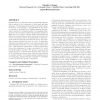Free Online Productivity Tools
i2Speak
i2Symbol
i2OCR
iTex2Img
iWeb2Print
iWeb2Shot
i2Type
iPdf2Split
iPdf2Merge
i2Bopomofo
i2Arabic
i2Style
i2Image
i2PDF
iLatex2Rtf
Sci2ools
ICFP
2001
ACM
2001
ACM
Recursive Structures for Standard ML
Standard ML is a statically typed programming language that is suited for the construction of both small and large programs. "Programming in the small" is captured by Standard ML's Core language. "Programming in the large" is captured by Standard ML's Modules language that provides constructs for organising related Core language definitions into self-contained modules with descriptive interfaces. While the Core is used to express details of algorithms and data structures, Modules is used to express the overall architecture of a software system. In Standard ML, modular programs must have a strictly hierarchical structure: the dependency between modules can never be cyclic. In particular, definitions of mutually recursive Core types and values, that arise frequently in practice, can never span module boundaries. This limitation compromises modular programming, forcing the programmer to merge conceptually (i.e. architecturally) distinct modules. We propose a...
| Added | 13 Dec 2009 |
| Updated | 13 Dec 2009 |
| Type | Conference |
| Year | 2001 |
| Where | ICFP |
| Authors | Claudio V. Russo |
Comments (0)

